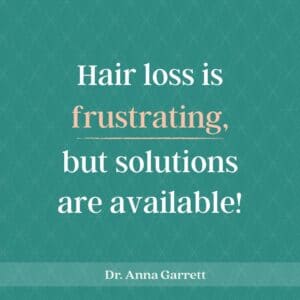Hair loss in perimenopause is one of the most distressing symptoms women experience, particularly if their hair has always been a source of pride.
Hair loss happens in perimenopause for many reasons. Hormonal fluctuations are responsible for hair loss during perimenopause and menopause. Estrogen and progesterone keep the hair in the growing phase, making it grow faster and stay on the head longer. When estrogen and progesterone levels decline, hair growth slows, and hair loss becomes more pronounced.
Also, the body produces more androgens during perimenopause and menopause in response to the loss of estrogen and progesterone. Androgens shrink hair follicles, which causes hair loss on the head and hair growth on the chin. YIKES!
But What Else Might Be Going On?
Let’s start at the beginning. The hair growth cycle consists of three distinct stages: anagen, catagen, and telogen.
Anagen Phase
Your hair grows around half an inch a month [about 6 inches a year] and faster in the summer than in winter. The growth phase, or anagen phase, lasts an average of 3-5 years — so a full-length hair averages 18 to 30 inches. The anagen phase is generally longer in people of Asian descent and can last as much as 7 years — meaning your hair may be able to grow up to 3 feet long!
Catagen Phase
Your hair enters the catagen phase at the end of the anagen phase. This short transitional phase lasts approximately 10 days.
Telogen Phase
Finally, your hair enters the telogen phase, a resting phase when strands are released and fall out. The follicle then remains inactive for 3 months, before the whole process repeats.
Beyond Sex Hormones: More Reasons for Hair Loss
Three very common reasons for hair loss in perimenopause are high-stress levels, low ferritin, and hyper or hypothyroidism. Let’s look at stress and cortisol first.
The hypothalamic-pituitary-adrenal (HPA) axis controls cortisol function. It regulates the body’s reaction to stress and ensures that the body can respond immediately to stressful events and return to a normal state just as quickly. A stressful situation triggers a reaction in the hypothalamus in the brain, which then continues through the pituitary gland, and ends in the adrenal glands where cortisol, norepinephrine, and adrenaline are produced.
Your hair shafts have their own mini-HPA axis. High cortisol and norepinephrine push the hair into the resting phase more quickly, resulting in hair loss. This effect lasts for MONTHS (3 or more).
How Do I Know if I Have High Cortisol?
High cortisol is characterized by anxiety, heart palpitations, sugar cravings, high blood pressure, and a “wired” feeling (among other things). This is assessed by a DUTCH test (see below). A ramped-up HPA axis looks like this graph below. This client’s cortisol and DHEA levels are through the roof, and she is definitely in need of HPA calming strategies!

Low Ferritin
Ferritin is a measure of iron stores. Years of heavy, prolonged periods can deplete ferritin, even if the rest of your iron tests look fine. Women with iron deficiency status are at a risk of telogen hair loss. In women without systemic inflammation or other underlying disorders, serum ferritin levels below or equal to 30 ng/mL are strongly associated with telogen hair loss. An ideal ferritin level is between 70 and 150 ng/mL.
Thyroid Problems
Disrupting thyroid hormone production, specifically T3 and T4, affects other processes in the body. This includes the development of hair at the root. Hair falls out and may not be replaced by new growth, resulting in thinning across your scalp and other areas such as your eyebrows.
Hair loss may develop slowly with hypothyroidism and hyperthyroidism.
However, hypothyroidism is much more common in women than hyperthyroidism. You won’t necessarily notice patches missing or bald spots. Instead, your hair may seem thinner all over. Ask your healthcare provider to run a FULL thyroid panel which includes free T3, free T4, reverse T3, TPO, and thyroglobulin antibodies.
The good news is that hair loss caused by thyroid conditions is typically temporary and improves with regulated thyroid function.
Autoimmune Disease
Autoimmune diseases can cause some form of hair loss. Alopecia Areata (your immune system attacks hair follicles) and Alopecia Universalis are specific autoimmune hair loss conditions. Hair loss can also result from Hashimoto’s thyroiditis, Crohn’s disease, psoriasis, rheumatoid arthritis, lupus, and Grave’s disease. Since many autoimmune conditions arise from poor gut health, this is a key area to pay attention to. Gluten removal can also help. Unfortunately, in some cases, this hair loss will be irreversible due to scarring that occurs on the scalp.
Once You’ve Tackled the Root Cause….
Hair loss is one of the most frustrating experiences for midlife women. Unfortunately, there is no quick solution. The first step is to identify the underlying cause and then address it. Balancing hormones, stress management, iron supplementation, and getting thyroid function regulated are generally the first steps.
Once you’ve tackled step one, you may want to try adding some of the following:
- Adaptogenic herbs that are calming (like holy basil) if cortisol is the problem. You can find recommended brands here.
- Add a drop or two of rosemary or peppermint essential oil to shampoo or a hair mask. Make sure it gets all the way to the scalp. This stimulates the hair follicles. Don’t use undiluted, or you may burn your scalp. Too much may cause you to wind up with oily hair. You can find these oils here.
- Castor oil. Make castor oil into a hair mask to encourage hair growth. You can also use this on your eyebrows and lashes.
- Biotin. This is a B vitamin that helps hair, skin, and nails.
- Collagen. You can supplement with powdered collagen or make your own bone broth.
 The Bottom Line
The Bottom Line
Hair loss in perimenopause and menopause can be frustrating, but solutions are available once the root cause is identified. And patience is required! If you’re struggling and not getting any answers, let’s talk. We can make a plan to investigate the source of your hair loss and then target an approach to solve the underlying problem.
Dr. Anna Garrett is a menopause expert and Doctor of Pharmacy. She helps women who are struggling with symptoms of perimenopause and menopause find natural hormone balancing solutions so they can rock their mojo through midlife and beyond. Dr. Anna is the author of Perimenopause: The Savvy Sister’s Guide to Hormone Harmony. Order your copy at www.perimenopausebook.com.
Dr. Anna is available for 1-1 consultation. Find out more at www.drannagarrett.com/lets-talk




